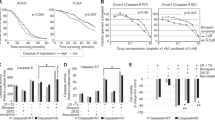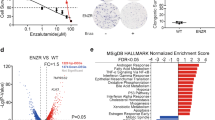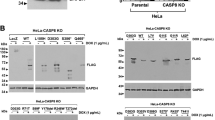Abstract
Caspase-8 is frequently deficient in several kinds of human tumors, suggesting that certain effects of this enzyme restrict tumor development. To examine the nature of the cellular function whose regulation by caspase-8 contributes to its antitumor effect, we assessed the impact of caspase-8 deficiency on cell transformation in vitro. Caspase-8-deficient mouse embryonic fibroblasts immortalized with the SV40 T antigen did not survive when cultured in soft agar, and were nontumorogenic in nude mice. However, the rate of transformation of these cells during their continuous growth in culture, as reflected in the observed emergence of cells that do grow in soft agar and are able to form tumors in nude mice, was far higher than that of cells expressing caspase-8. These findings indicate that caspase-8 deficiency can contribute to cancer development in a way that does not depend on the enzyme's participation in killing of the tumor cells by host immune cytotoxic mechanisms, or on its involvement in the cell-death process triggered upon detachment of the cells from their substrate, but rather concerns cell-autonomous mechanisms that affect the rate of cell transformation.
Similar content being viewed by others
Log in or create a free account to read this content
Gain free access to this article, as well as selected content from this journal and more on nature.com
or
Abbreviations
- CHI:
-
cycloheximide
- DMEM:
-
Dulbecco's modified Eagle's minimal essential medium
- FCS:
-
fetal calf serum
- DMEM–FCS:
-
DMEM supplemented with 10% FCS
- KO:
-
knockout
- MEF:
-
mouse embryonic fibroblasts
- PBS:
-
phosphate-buffered saline
- WT:
-
wild type
References
Joseph B, Ekedahl J, Sirzen F, Lewensohn R, Zhivotovsky B . Differences in expression of pro-caspases in small cell and non-small cell lung carcinoma. Biochem Biophys Res Commun 1999; 262: 381–387.
Teitz T, Wei T, Valentine MB, Vanin EF, Grenet J, Valentine VA et al. Caspase 8 is deleted or silenced preferentially in childhood neuroblastomas with amplification of MYCN. Nat Med 2000; 6: 529–535.
Soung YH, Lee JW, Kim SY, Sung YJ, Park WS, Nam SW et al. Caspase-8 gene is frequently inactivated by the frameshift somatic mutation 1225_1226delTG in hepatocellular carcinomas. Oncogene 2005; 24: 141–147.
Liedtke C, Zschemisch NH, Cohrs A, Roskams T, Borlak J, Manns MP et al. Silencing of caspase-8 in murine hepatocellular carcinomas is mediated via methylation of an essential promoter element. Gastroenterology 2005; 129: 1602–1615.
Boldin MP, Goncharov TM, Goltsev YV, Wallach D . Involvement of MACH, a novel MORT1/FADD-interacting protease, in Fas/APO1- and TNF receptor-induced cell death. Cell 1996; 85: 803–815.
Muzio M, Chinnaiyan AM, Kischkel FC, O'Rourke K, Shevchenko A, Ni J et al. FLICE, a novel FADD-homologous ICE/CED-3-like protease, is recruited to the CD95 (Fas/APO-1) death-inducing signaling complex. Cell 1996; 85: 817–827.
Rytomaa M, Martins LM, Downward J . Involvement of FADD and caspase-8 signalling in detachment-induced apoptosis. Curr Biol 1999; 9: 1043–1046.
Frisch SM . Evidence for a function of death-receptor-related, death-domain-containing proteins in anoikis. Curr Biol 1999; 9: 1047–1049.
Stupack DG, Puente XS, Boutsaboualoy S, Storgard CM, Cheresh DA . Apoptosis of adherent cells by recruitment of caspase-8 to unligated integrins. J Cell Biol 2001; 155: 459–470.
Stupack DG, Teitz T, Potter MD, Mikolon D, Houghton PJ, Kidd VJ et al. Potentiation of neuroblastoma metastasis by loss of caspase-8. Nature 2006; 439: 95–99.
Salmena L, Lemmers B, Hakem A, Matysiak-Zablocki E, Murakami K, Au PY et al. Essential role for caspase 8 in T-cell homeostasis and T-cell-mediated immunity. Genes Dev 2003; 17: 883–895.
Kang TB, Ben-Moshe T, Varfolomeev EE, Pewzner-Jung Y, Yogev N, Jurewicz A et al. Caspase-8 serves both apoptotic and nonapoptotic roles. J Immunol 2004; 173: 2976–2984.
Suzuki J, Sukezane T, Akagi T, Georgescu MM, Ohtani M, Inoue H et al. Loss of c-abl facilitates anchorage-independent growth of p53- and RB-deficient primary mouse embryonic fibroblasts. Oncogene 2004; 23: 8527–8534.
May T, Mueller PP, Weich H, Froese N, Deutsch U, Wirth D et al. Establishment of murine cell lines by constitutive and conditional immortalization. J Biotechnol 2005; 120: 99–110.
Dong Z, Cmarik JL . Harvesting cells under anchorage-independent cell transformation conditions for biochemical analyses. Sci STKE 2002; 2002: PL7.
Raptis L, Vultur A . Neoplastic transformation assays. In: Raptis L (ed). SV40 Protocols, vol. 165 Humana Press Inc.: Totowa, NJ, 2001, pp 151–164.
Ahuja D, Saenz-Robles MT, Pipas JM . SV40 large T antigen targets multiple cellular pathways to elicit cellular transformation. Oncogene 2005; 24: 7729–7745.
Sekido Y, Fong KM, Minna JD . Molecular genetics of lung cancer. Annu Rev Med 2003; 54: 73–87.
Laurent-Puig P, Zucman-Rossi J . Genetics of hepatocellular tumors. Oncogene 2006; 25: 3778–3786.
Hahn WC, Weinberg RA . Modelling the molecular circuitry of cancer. Nat Rev 2002; 2: 331–341.
Fanslow WC, Anderson DM, Grabstein KH, Clark EA, Cosman D, Armitage RJ . Soluble forms of CD40 inhibit biologic responses of human B cells. J Immunol 1992; 149: 655–660.
Ramakrishnan P, Wang W, Wallach D . Receptor-specific signaling for both the alternative and the canonical NF-kappaB activation pathways by NF-kappaB-inducing kinase. Immunity 2004; 21: 477–489.
Varfolomeev EE, Schuchmann M, Luria V, Chiannilkulchai N, Beckmann JS, Mett IL et al. Targeted disruption of the mouse Caspase 8 gene ablates cell death induction by the TNF receptors, Fas/Apo1, and DR3 and is lethal prenatally. Immunity 1998; 9: 267–276.
Todaro GJ, Green H . Quantitative studies of the growth of mouse embryo cells in culture and their development into established lines. J Cell Biol 1963; 17: 299–313.
Almazan G, McKay R . An oligodendrocyte precursor cell line from rat optic nerve. Brain Res 1992; 579: 234–245.
Acknowledgements
We thank Dr. Raya Eilam-Altstadter for help in quantifying the growth of colonies in soft agar, and Inna Kolesnik and Tatiana Shalevich for genotyping the mice. This study was supported in part by grants from Ares Trading SA, Switzerland; a Center of Excellence Grant from the Flight Attendant Medical Research Institute (FAMRI); and the Kekst Family Center for Medical Genetics at The Weizmann Institute of Science.
Author information
Authors and Affiliations
Corresponding author
Additional information
Edited by G Melino
Rights and permissions
About this article
Cite this article
Krelin, Y., Zhang, L., Kang, TB. et al. Caspase-8 deficiency facilitates cellular transformation in vitro. Cell Death Differ 15, 1350–1355 (2008). https://doi.org/10.1038/cdd.2008.88
Received:
Revised:
Accepted:
Published:
Issue date:
DOI: https://doi.org/10.1038/cdd.2008.88
Keywords
This article is cited by
-
Caspase 8 deletion causes infection/inflammation-induced bone marrow failure and MDS-like disease in mice
Cell Death & Disease (2024)
-
Caspase-2 as a tumour suppressor
Cell Death & Differentiation (2013)
-
Caspases and cancer
Cell Death & Differentiation (2011)
-
Phosphorylation by polo-like kinase 1 induces the tumor-suppressing activity of FADD
Oncogene (2011)



